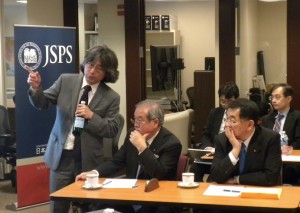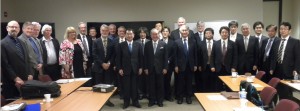There was a visit by Japanese Diet members to Washington DC from 26 to 29 April (see “Discussions at the political level over the ILC in US and Europe” in this issue of LC NewsLine). I attended two of those meetings, one on 28 April at the Hudson Institute and one on 29 April at the Japanese Society for the Promotion of Science (JSPS) in Washington, D.C.
Since the other article already describes the 28-April meeting, I will concentrate here on other one. The meeting was graciously hosted by the new director of JSPS in Washington , Mitsuaki Nozaki, former Asian Director for ILC’s Global Design Effort. It was attended by Diet members Mr. Ryu Shionoya and Mr. Shun-ichi Suzuki and several researches from Japan, including Satoru Yamashita, Hitoshi Murayama, Atsuto Suzuki and several others. The purpose of the meeting was to update our Japanese colleagues on activities related to ILC in the US. The attendance from the US and from Europe consisted of Lyn Evans (LCC Director), Andy Lankford (HEPAP chair), Jim Siegrist and Michael Salamon (DOE), as well as represenatives from US institutions: Mike Harrison, Paul Grannis, Dmitri Denisov, Jim Brau, Andy White, Marc Ross, and myself.
The meeting started with status reports on High Energy Physics Advisory Panel (HEPAP) and P5 (Lankford), US status (Siegrist), ILC status (Evans) followed by activity reports on superconducting radio frequency (SRF) R&D at Fermilab (Denisov), the Linac Coherent Light Source (Ross), ILC detector Ttchnology (White) and international collaborations (Grannis).
The agenda and talks are at https://agenda.linearcollider.org/event/6745/.

LCC Deputy Director Hitoshi Murayama (left) explains ILC physics to Japanese Diet members Mr. Suzuki (middle) and Mr. Shionoya (right) at JSPS Washington
In my mind the situation in the US can be best described like this: following the P5 recommendations there is support in the US for participation in the Linear Collider Collaboration, support for accelerator R&D in areas where the US contributes uniquely and an overall effort in SRF R&D to improve cavity performance, which might lead to a cost reduction in the overall ILC project. Efforts on physics and detector developments and R&D exist, but are at a minimal level.
At the meeting a handout was distributed by our Japanese colleagues, in which the suggestion was made for a US- Japan congressional caucus to be formed to discuss scientific and technical projects like nuclear energy, the International Space Station, advanced computing, or future colliders, with ILC as the obvious intended focus. This was also raised at the meeting on 28 April, but not as concrete as it was described at this meeting. It was also suggested that a US researcher be identified who would be the conduit to the caucus to educate and inform them of developments.
The handout and proposal by our Japanese colleagues, was a new suggestion and a bit of a surprise to the US side, but it was decided that the American Linear Collider Committee (ALCC) would take this under consideration and see how these suggestions can be implemented in the US and in the US system. This has been discussed at the follow-up ALCC meeting at the beginning of May. As another follow-up to the 28-April meeting there was a meeting between US researchers and the president of the Hudson Institute, Ken Weinstein. The purpose of the meeting was to provide some more background to the Hudson Institute on high-energy physics, its global nature and how the ILC fits in, as well as to start exploring how this institute may help with making the ILC part of a broader Japan-US science and technology framework that enables discussions between the two countries, including the ILC.



Recent Comments